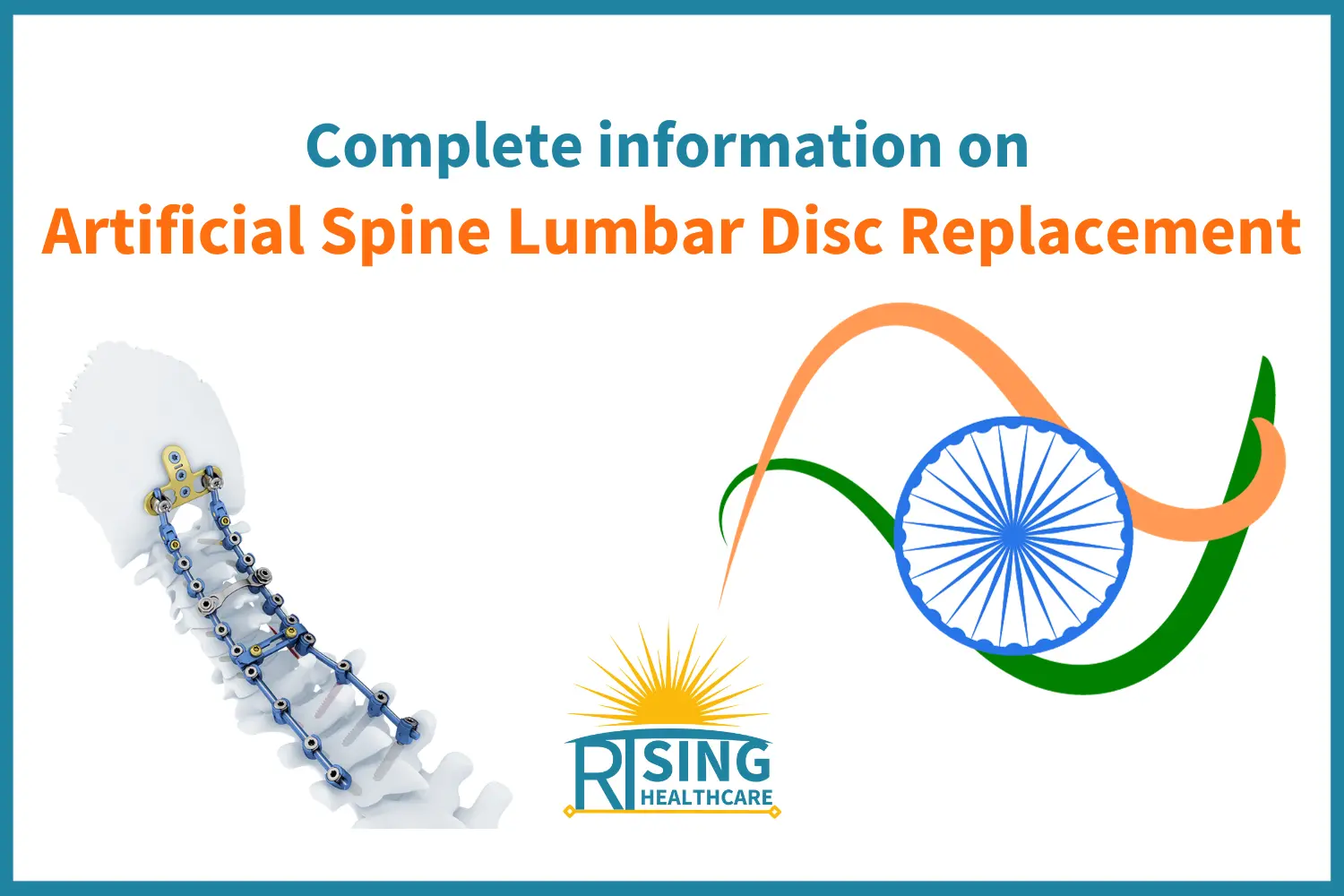
Exploring Artificial Spine Lumbar Disc Replacement: A Modern Solution for Back Pain
Introduction
Back pain is a common ailment that affects millions of people worldwide. Among the various causes of back pain, issues related to the lumbar spine, specifically the lumbar discs, are frequently seen. Lumbar disc problems can lead to debilitating pain and reduced quality of life. Traditional treatments like physical therapy, medications, and spinal fusion have been the go-to options, but recent advancements in medical technology have given rise to a promising alternative – Artificial Spine Lumbar Disc Replacement. In this article, we will delve into the world of lumbar disc replacement, spinal disc replacement, and the benefits of artificial disc replacement in the lumbar region.
Contents
Understanding the Lumbar Disc
The lumbar spine, commonly known as the lower back, plays a crucial role in supporting the upper body and facilitating various movements. It consists of five vertebrae, labeled L1 to L5, and between each pair of adjacent vertebrae lies a lumbar disc. These discs are the shock absorbers of the spine, cushioning the vertebrae and allowing for flexible movements like bending and twisting.
Lumbar discs have two primary components:
- Annulus Fibrosus: This is the tough, outer layer of the disc, made up of several layers of fibrous tissue. It provides strength and stability to the disc.
- Nucleus Pulposus: Situated in the center of the disc, this gel-like substance absorbs shocks and provides flexibility to the spine.
The Problem with Lumbar Discs
Over time, lumbar discs can undergo wear and tear due to age, injury, or other factors. Common issues that can arise include:
- Disc Degeneration: The discs lose their water content and become less flexible, leading to stiffness and reduced shock-absorbing ability.
- Herniation: Sometimes, the nucleus pulposus can push through a tear in the annulus fibrosus, causing a herniated disc. This can press on nearby nerves, resulting in pain and discomfort.
- Bulging Disc: A bulging disc occurs when the disc’s outer layer weakens and protrudes, potentially compressing spinal nerves.
- Sciatica: If a lumbar disc problem puts pressure on the sciatic nerve, it can cause pain, numbness, and tingling sensations in the legs and buttocks.
Traditional Treatments for Lumbar Disc Problems
Historically, when individuals experienced severe lumbar disc issues, the go-to treatment was spinal fusion surgery. In this procedure, the damaged disc is removed, and the adjacent vertebrae are fused together using hardware like screws and rods. While spinal fusion can provide relief, it also limits the spine’s natural movement.
Moreover, fusion surgery may lead to adjacent segment disease, where the discs above and below the fused area deteriorate due to increased stress and strain. This can necessitate further surgeries in the future.
The Promise of Lumbar Disc Replacement
In recent years, the medical field has witnessed significant advancements in the treatment of lumbar disc problems, one of which is Lumbar Disc Replacement (LDR). LDR is also known as Spinal Disc Replacement or Artificial Disc Replacement Lumbar. This innovative procedure aims to replace a damaged lumbar disc with an artificial disc, preserving the spine’s mobility and reducing the risk of adjacent segment disease.
Key Advantages of Lumbar Disc Replacement
- Preservation of Motion: Unlike spinal fusion, which limits motion in the treated area, lumbar disc replacement allows the spine to maintain its natural range of motion. This can lead to improved functionality and a better quality of life.
- Reduced Risk of Adjacent Segment Disease: Since adjacent discs aren’t fused together, there is a lower risk of deterioration in nearby discs. This can potentially reduce the need for additional surgeries in the future.
- Pain Relief: Many patients experience significant pain relief following lumbar disc replacement. By removing the damaged disc and replacing it with an artificial one, pressure on nerves is alleviated, leading to reduced pain and discomfort.
- Shorter Recovery Time: Lumbar disc replacement often involves a shorter recovery period compared to spinal fusion. Patients can typically return to their normal activities sooner.
- Improved Long-term Outcomes: Studies have shown that lumbar disc replacement can provide long-term benefits, including sustained pain relief and improved function, for many patients.
The Lumbar Disc Replacement Procedure
Lumbar disc replacement is a surgical procedure that involves several steps:
- Patient Evaluation: Before the surgery, the patient undergoes a thorough evaluation, including imaging tests like MRI or CT scans to determine the extent of disc damage.
- Anesthesia: The patient is placed under general anesthesia to ensure they remain pain-free and unconscious throughout the procedure.
- Incision: A small incision is made in the abdomen, allowing access to the lumbar spine.
- Removal of Damaged Disc: The damaged lumbar disc is carefully removed.
- Artificial Disc Placement: An artificial disc made of biocompatible materials is inserted into the space previously occupied by the damaged disc. This replacement disc is designed to mimic the function of a natural disc.
- Closure: The incision is closed, and the patient is monitored as they recover from anesthesia.
Recovery and Rehabilitation
After lumbar disc replacement surgery, patients typically stay in the hospital for a short period for observation. Depending on the individual and the surgical approach used, the recovery period may vary, but most patients can expect the following:
- Physical Therapy: Rehabilitation exercises are crucial to help the patient regain strength and mobility. Physical therapy may start soon after the surgery.
- Pain Management: Pain management strategies are employed to ensure the patient is comfortable during the recovery process.
- Activity Restrictions: Patients are advised to avoid strenuous activities and heavy lifting during the initial recovery period.
- Follow-up Appointments: Regular follow-up appointments with the surgeon are essential to monitor the healing process and address any concerns.
- Gradual Return to Normal Activities: Over time, patients can gradually resume their normal daily activities and even engage in light exercise.
Candidates for Lumbar Disc Replacement
Lumbar disc replacement may not be suitable for everyone. Candidates for this procedure typically meet certain criteria, which may include:
- Failed Conservative Treatments: Candidates have often tried conservative treatments like physical therapy, medications, and injections without sufficient relief.
- Specific Disc Damage: The damage should be localized to one or two lumbar discs, and there should be no severe instability in the spine.
- Good General Health: Candidates should generally be in good health, without underlying conditions that might complicate surgery or recovery.
- Non-Smokers: Smoking can impair the healing process, so candidates are usually advised to quit smoking before undergoing the procedure.
- Realistic Expectations: Candidates should have realistic expectations about the outcomes of the surgery and be committed to the post-operative rehabilitation process.
Conclusion
Lumbar disc problems can cause significant pain and discomfort, affecting a person’s quality of life. While traditional treatments like spinal fusion have been effective, they come with limitations. Lumbar Disc Replacement (LDR), also known as Spinal Disc Replacement or Artificial Disc Replacement Lumbar, offers a promising alternative.
By preserving the spine’s natural mobility and reducing the risk of adjacent segment disease, LDR provides several advantages over spinal fusion. Patients who undergo lumbar disc replacement often experience pain relief and improved function, enabling them to return to their daily activities with reduced restrictions.
As medical technology continues to advance, lumbar disc replacement is becoming more accessible to those in need. If you or a loved one is struggling with lumbar disc issues, consult with a spine specialist to determine if lumbar disc replacement is a viable option for a pain-free and active future. Remember, your spine plays a vital role in your overall well-being, and modern medical innovations are here to help you maintain a healthy, active lifestyle.

